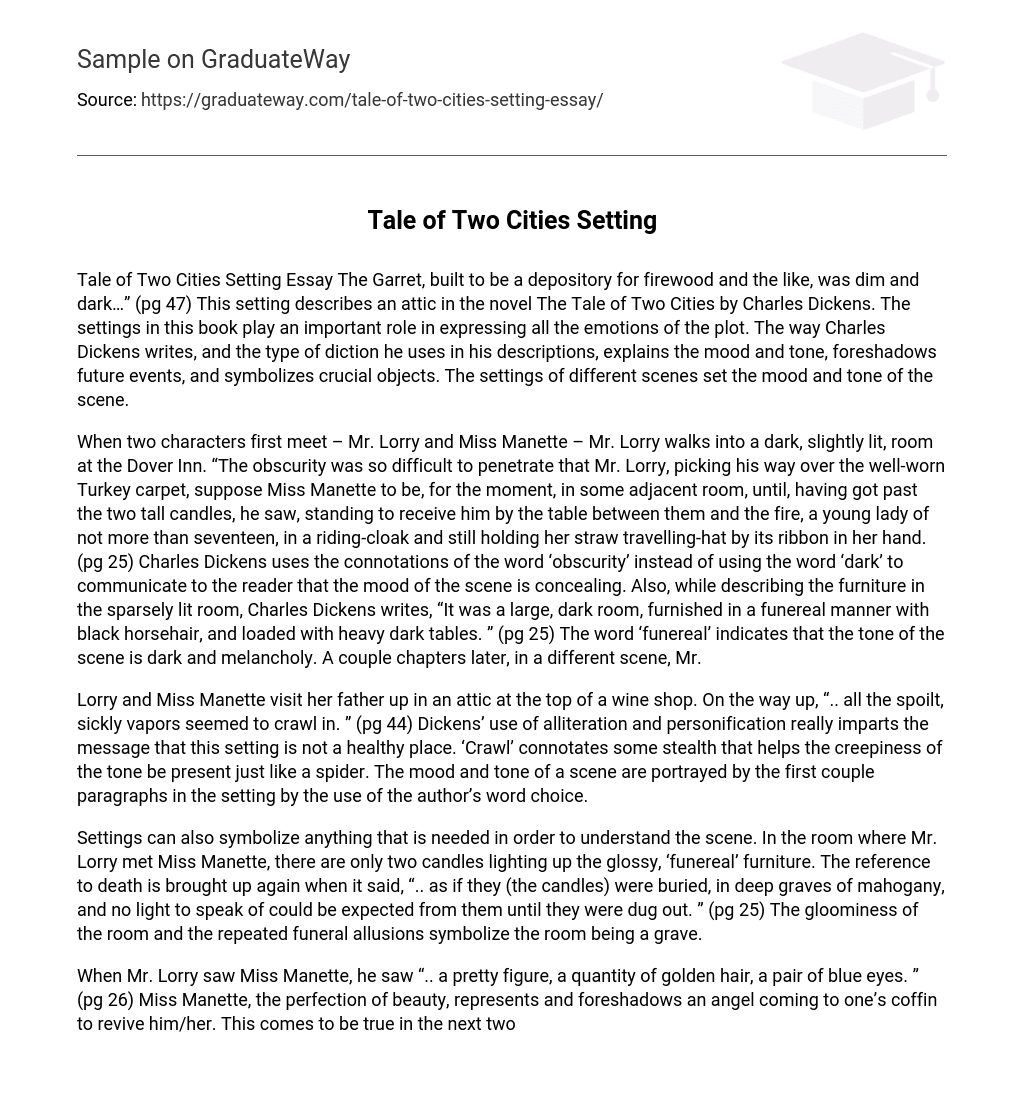The Garret, built to be a depository for firewood and the like, was dim and dark…” This setting describes an attic in the novel The Tale of Two Cities by Charles Dickens. The settings in this book play an important role in expressing all the emotions of the plot. The way Charles Dickens writes, and the type of diction he uses in his descriptions, explains the mood and tone, foreshadows future events, and symbolizes crucial objects. The settings of different scenes set the mood and tone of the scene. When two characters first meet – Mr. Lorry and Miss Manette – Mr. Lorry walks into a dark, slightly lit, room at the Dover Inn. “The obscurity was so difficult to penetrate that Mr. Lorry, picking his way over the well-worn Turkey carpet, suppose Miss Manette to be, for the moment, in some adjacent room, until, having got past the two tall candles, he saw, standing to receive him by the table between them and the fire, a young lady of not more than seventeen, in a riding-cloak and still holding her straw travelling-hat by its ribbon in her hand.
Charles Dickens uses the connotations of the word ‘obscurity’ instead of using the word ‘dark’ to communicate to the reader that the mood of the scene is concealing. Also, while describing the furniture in the sparsely lit room, Charles Dickens writes, “It was a large, dark room, furnished in a funereal manner with black horsehair, and loaded with heavy dark tables. ” The word ‘funereal’ indicates that the tone of the scene is dark and melancholy. A couple chapters later, in a different scene, Mr. Lorry and Miss Manette visit her father up in an attic at the top of a wine shop. On the way up, “.. all the spoilt, sickly vapors seemed to crawl in. ” (pg 44) Dickens’ use of alliteration and personification really imparts the message that this setting is not a healthy place. ‘Crawl’ connotates some stealth that helps the creepiness of the tone be present just like a spider. The mood and tone of a scene are portrayed by the first couple paragraphs in the setting by the use of the author’s word choice.
Settings can also symbolize anything that is needed in order to understand the scene. In the room where Mr. Lorry met Miss Manette, there are only two candles lighting up the glossy, ‘funereal’ furniture. The reference to death is brought up again when it said, “.. as if they (the candles) were buried, in deep graves of mahogany, and no light to speak of could be expected from them until they were dug out. ” The gloominess of the room and the repeated funeral allusions symbolize the room being a grave. When Mr. Lorry saw Miss Manette, he saw “.. a pretty figure, a quantity of golden hair, a pair of blue eyes. ” Miss Manette, the perfection of beauty, represents and foreshadows an angel coming to one’s coffin to revive him/her. This comes to be true in the next two chapters when Miss Manette finally meets her father, driven crazy from eighteen years in prison.
“His cold white head mingled with her radiant hair which warmed and lighted it as though it were the light of Freedom shining on him. (pg 57) This quote, again, symbolizes Miss Manette as a messenger of God, or of Freedom, sent to rescue her father from his own mind. Symbolizing and foreshadowing Miss Manette’s future was present in both scene’s settings. The two scenes that are talked about, are in different parts of the novel, but they are almost identical. The Dover Inn room is only slightly lit, while the Garret is almost completely dark. “Such a scanty portion of light was admitted through these means, that it was difficult, on first coming in, to see anything. Both scenes have a specific object of interest. At the Dover Inn, most of the light is directly on Miss Manette, and in the Garret, a ray of light is shining only on her father. “A broad ray of light fell into the garret, and showed the workman with an unfurnished shoe upon his lap, pausing in his labour. ” Both Miss Manette and her father are introduced in identical situations to show that their futures are intertwined and that they are both blessed by God.
Also, the tones of the two scenes are very alike – quite, suspenseful, and hopeful at the end. At the end of the second scene, the following quote says “.. sitting opposite the buried man who had been dug out, and wondering what subtle powers were for ever lost to him, and what were capable of resoration…”(pg 61) The two scenes complete each other: in the first one, the scene foreshadows that Miss Manette will rescue her father and in the second scene, Miss Manette does actually save her father. The settings of this novel, A Tale of Two Cities, are considerably important. Charles Dickens, the author, wrote the settings to help the reader understand the plot by using unique word choice that sets the mood and tone and also foreshadows parts of the story. Dickens uses similar settings in two different scenes to display that the scenes are related to each other and carry the same message. Setting details are crucial in any novel.





